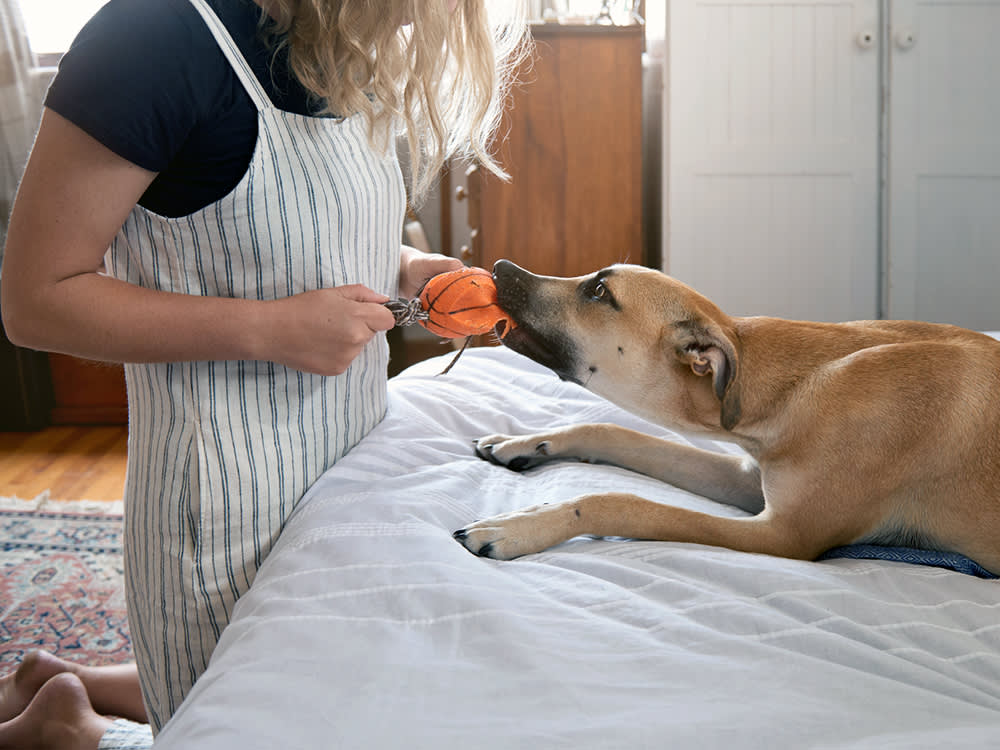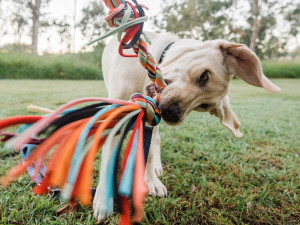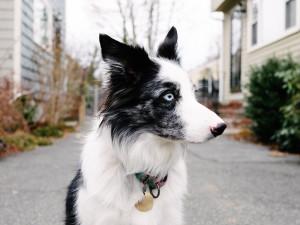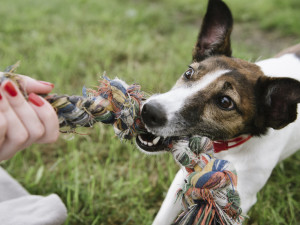Playing Tug With Your Dog Is Good Exercise For Both Of You
Basics of the tug game and how to troubleshoot common problems.
There’s a lot of information floating around the Internet about what games you play with your dog that make them quietly go insane. Rest assured, there’s one game you can still play with your pup that will only make you insane — tug!
Canine behavior experts have given the game their seal of approval, though there are caveats. Dogs who like it — which is most of them — get a lot from it; even some who don’t take to it immediately can learn to enjoy it. One of the beautiful things about this game is that for most dogs, nobody has to teach them how to do it. Even puppies still adorably tripping over their own feet play tug games. It’s that natural for them.
Trick question: All dogs are perfect! But find out which type is the best fit for you.
But it’s uncommon to meet dogs with a casual interest in the game — dogs tend to either love to play tug or have little interest in it all. Here are the ins and outs of the game for new pet parents or for seasoned pet parents who have never known there was anything more to know than “pull.”
Why Do Dogs Like Tug of War?
For the ones who adore it, tug offers a way to engage them in play, exercise them, teach them skills they need to play safely so it’s fun for people and dogs alike, and reinforce them with something valuable.
How much do you spend on your pet per year?
And for a game you can play in a relatively small space, it’s remarkably tiring for your dog. The high-intensity nature of tug relaxes a lot of dogs, improving their emotional state and leaving them calm and contented after a good session.
You can play tug with dogs indoors — great news when it’s stifling hot, pouring rain or too cold to enjoy being outside for long. Playing outdoors is wonderful, too, but it’s nice to have an indoor option. Tug is an easy game, it requires no great skill to play. Simplicity is always a gift, and tug offers it.
How to Play Tug-of-War With Your Dog
Though training isn’t necessary for most dogs to enjoy this natural and fun game, some need a little encouragement to join in. Some timid dogs show a bit of hesitancy about pulling on an object when a person picks it up or has it in hand. To get such dogs fully on board with tug, it helps to signal to your dog that you want to play.
Offer a modified play bow by bending your knees and leaning over at the waist, then wave a long toy on the ground to get their attention. For dogs who aren’t naturals at tug, putting a toy on the ground and then moving it around or waving it back and forth will get the game going. Many dogs who are tug converts learned to play it this way.
Calmly praise them for approaching the toy and for taking hold of it. Keep that gentle praise coming as they grab the toy, then pull back gently. For a dog who’s a bit unsure, it’s important that you refrain from pulling hard or waving the toy frantically. Keep things nice and easy. Be chill.
If your dog will grab the toy but won’t pull on it, use only the tiniest bit of pressure when you pull the toy to make it more likely that they will hang on to it. Once they’re regularly and reliably holding on, gradually increase the force you use to pull. Before long, they’re likely to match your effort. And voilà — a game of tug will be in session.
What about tug-of-war with a teething puppy?
Tug can be fun, but playing with a dog who gradually moves their mouth up the tug toy toward your hand can suck the joy out of the game really fast. Safety is always the primary goal, so if your dog is a creeper, it’s a good idea to make some adjustments to protect your delicate human hand from the teeth and powerful jaws of your dog’s mouth.
There are two ways to do this. One is to use a really long toy, which requires your dog to move quite a way up the toy before the situation becomes troublesome. A second is to grab the end of the toy they originally had and reset the game; in this case, you’ll be holding the end opposite from where you started.
How do you do this? As they approach your end of the toy, drop it and reach for the end of their side. This takes coordination, speed and practice, but quickly becomes quite natural. There may be a few collisions during the learning process, so be careful.
If neither of those methods are enough to manage the issue, entice them with a second tug toy, then switch between the two as needed. Or, finally, end the game when their mouth starts to travel along the toy toward you. Many dogs are more likely to stick to their end of the toy once they figure out that doing otherwise hastens the end of the game.
Is Tug of War Bad for Dogs?
Years ago, playing tug was not considered a great idea with dogs. There were concerns about allowing the dogs to use the full force of their mouths around people’s hands and about tug leading to over-arousal. Many also feared that allowing dogs to “win” by ending up with the toy would lead to trouble in the form of dogs throwing their weight around because they had succeeded in tug. Knowledge and beliefs are constantly changing, and now, the benefits of tug are more universally recognized.
However, research by Rooney and Bradshawopens in new tab reported in 2002 suggests that allowing a certain type of dog to keep the toy after a game of tug can create a different issue. In their study, they observed that the most playful dogs became pushier for attention from their owners if they were allowed to keep the toy after tug games.
This is easy to avoid. If your dog is really persistent and likely to pester you to play, simply put the toy out of reach when the tug game is over.
How Long Should You Play Tug of War With Your Dog?
Some dogs never tire of tug and are willing to play until their person is ready to stop. Other dogs lose interest quickly even though their people want to keep playing. If your dog is one of the latter, making the game more exciting will help keep them interested.
How to Make Playing Tug More Interesting For Your Dog
Use the toy your dog is most interested in. For many dogs, the top-level toy is a really thick rope, two inches or so in diameter and at least two feet long, sometimes with a knot tied in each end to make it more grippable.
Play at the time of day during which your dog is the most energetic. For a lot of dogs, the best time to play tug is mid-morning or late afternoon, times when a majority of dogs are filled with energy and likely to be the most playful. If you’re not sure when your dog is most revved up, experiment with play at different times of day to figure out if it makes a difference in how long her interest lasts.
Some dogs find it more exciting to play tug if you pull the toy in a haphazard fashion rather than smoothly, and/or if you pull upward rather than straight and parallel to the ground. To keep from injuring either yourself or your dog, avoid pulling too jerkily or too high.
If your dog also enjoys fetch, combine tug with a retrieve. Throw the toy, and when your dog brings it back, reinforce with a game of tug. Don’t tug too long, though; before they lose interest, throw the toy again. Vary the fetch/tug ratio: Go from 1:1 to 1:3 or 1:4. Unpredictably mixing the two games keeps many dogs interested and willing to play longer.
Can a Dog Be Trained to Like Tug
If calmly pulling a toy along the ground doesn’t work, there’s another way to help a dog find their tug groove: Teach it as you would teach any other trick — such as “shake,” “roll over “or “wave good-bye” — through shaping, which is reinforcing successive approximations of the behavior you want to eventually achieve.
With tug, that means begin by reinforcing your dog for showing any interest in the toy, whether looking at it, approaching it, or poking at it with their paw or nose. Over time, raise your criteria so your dog has to do more to earn the treats. The series of steps may be touching the toy, remaining in physical contact with it a beat longer, mouthing it and grabbing it.
Eventually, offer your dog treats for pulling on the toy while you hold the other end, gradually requiring them to pull harder or longer to earn the reinforcement. Some dogs will only ever play tug in this kind of mechanical way, but others come to love it and begin to play the game just for the fun of it.
How to Keep a Dog From Becoming Overexcited Playing Tug
Though it takes effort to get some dogs get excited enough about tug to play, there are also dogs on the opposite end of the spectrum, ones who struggle with emotional control during tug. These dogs can get nippy, leap up on people or even pull them over. Such out-of-control behavior is generally all about arousal, and that must be addressed in order for tug to be fun for both of you.
Dogs need to develop and practice self-control to be able to play appropriately, and it’s easier for them to do that if we work on lowering their arousal level. Generally, the best advice is not to add to the arousal, and to do everything you can to control it.
Choose the tug toy carefully. Use one that doesn’t get the dog too revved up. Choose the time of day. Many dogs are naturally calmest in the middle of the day or after a long walk or run, and those might be the best times to play tug with a dog who is easily amped up during the game.
Take frequent breaks of 5 to 15 seconds to interrupt the upward spiral of enthusiasm. When you play, pull the toy in a slow, steady way, low and parallel to the ground rather than upward in a jerky or unpredictable way.
How to Help a Dog Accept the End of the Game
Some dogs are too enthusiastic about tug, and don’t take it well when the game ends. One of the best ways to handle this is to teach your dog that when you say “all done,” you will only tug for a few seconds more.
Communicating intent to end the game helps many dogs cope because they are not caught off guard. It’s tough for dogs who want to play tug endlessly to have it end without any warning.
Another way to ease the pain of ending the game is to follow it with something else your dog likes — a training session, a walk, a massage — so that they associate the end of a tug game with feeling happy.
Here’s the takeaway: Tug is fun and makes many dogs so happy. Let the games begin!









